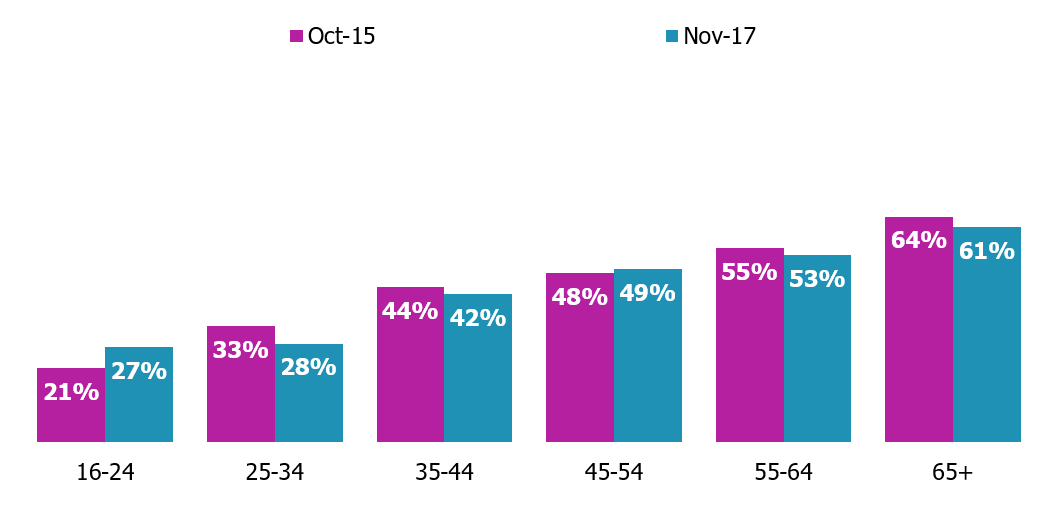People in the UK are living longer than ever before – a great achievement of modern science and healthcare. Yet this demographic change questions many conventional practices and policies, including service provision by charities. Here we look at findings from our latest research with the public and offer some data trends to think about.
Under 35s are much more likely to be interested in volunteering with older people than over 45s
Loneliness amongst older people is becoming recognised as a significant and growing societal problem. Around half of over-75-year-olds live alone, and 17% of older people are in contact with family and friends less than once a week. Volunteers offer a means to help alleviate said loneliness, but charities need to be aware of who is likely to want to volunteer with older people.
Older people are much less interested in volunteering to work with the elderly than younger people. This presents a challenge because those aged 45+ are traditionally among the most engaged volunteering groups. Charities working with older people will have to consider how they can attract those aged 45+ to volunteer for their cause.
Those with no interest in types of volunteering with older people:

Base: 1,000 adults 16+, Britain | Source: Charity Awareness Monitor, Nov 17, nfpSynergy
The good news is that volunteering among 16-24 year olds and 25-35 year olds has increased markedly since 2010, so older people’s charities can capitalise on the high number of younger people interested in volunteering with older people.
Thinking further about the issue of younger generations engaging with the elderly, it could also be a great opportunity to work on collaboration with other charities, for instance, those that work with younger people and kids. Nurseries within care homes exist in countries like Japan, Israel, the US, and Canada. There is one care home in the UK – Nightingale House – that welcomes kids from a nearby nursery to come and take part in activities with older people. Could there be room for more schemes like these that charities can develop?
Even internet literate over 65s prefer face to face and telephone methods over web-based approaches when accessing charity services
The last few years have seen increasing impetus to expand and improve digital services as a means to expand access to charity services and adapting fundraising practices to the digital age. However, there is a concern that this fast progress towards online services risks leaving older age groups less comfortable or even unable to engage with charities.
Research on local government service provision conducted by Age UK earlier this year revealed that two fifths of UK councils only allow housing benefit and council tax reduction to be claimed online, which Age UK argues is screening millions of older people who are not computer literate from claiming benefits that they are legally entitled to. With evidence that a significant proportion of over 65s are being left behind by digitisation in other sectors, we wanted to find out how older people engage with online services as opposed to more traditional ways of engaging with charity services.
At this point we also have to acknowledge that these findings came out of surveys conducted exclusively online, so our sample will only include those people who have used the internet. Around 90% of the British adult population report using the internet in the last 3 months (https://www.ons.gov.uk/businessindustryandtrade/itandinternetindustry/b…).
Our research in November 2017 shows that while some older people prefer going to a charity website to engage with most of the charity services, many older people still prefer personal contact when accessing charity services. When it comes to learning about welfare support availability, the service with the highest level of preferred online engagement (29%), 43% of over 65s prefer some form of personal contact, either face to face or over the phone.
Not surprisingly, over 65s are much less likely to prefer to use charity websites to access emotional support services than younger age groups, especially under 35s. 28% of 16-24 year olds prefer to use charity websites to access emotional support services, compared to 10% of over 65s.
With so many older people still preferring personal contact over digital, charities working with older people need to be aware of the risks of putting off service users when moving more and more of their services online.
Preferred methods for engaging with charity services among 65+ years

Charities that provide care for older people face unprecedented issues, not least a growing demographic. However, the public also recognises this demographic shift and is looking for the answers at the same time. In this regard, being aware of the public trends and attitudes towards these issues can greatly benefit charities strategising for the future now.
At nfpSynergy, our Charity Awareness Monitor measures public opinion on charities ranging from levels of trust to different motivations to support a variety of charity sectors. These remain key in understanding the public’s relationship with older people charities. Our research can be used to keep up-to-date with the reach of communication strategies, as well as monitoring success against other charity sectors.
Download our Charity Awareness Monitor briefing pack below to see this research in detail.

